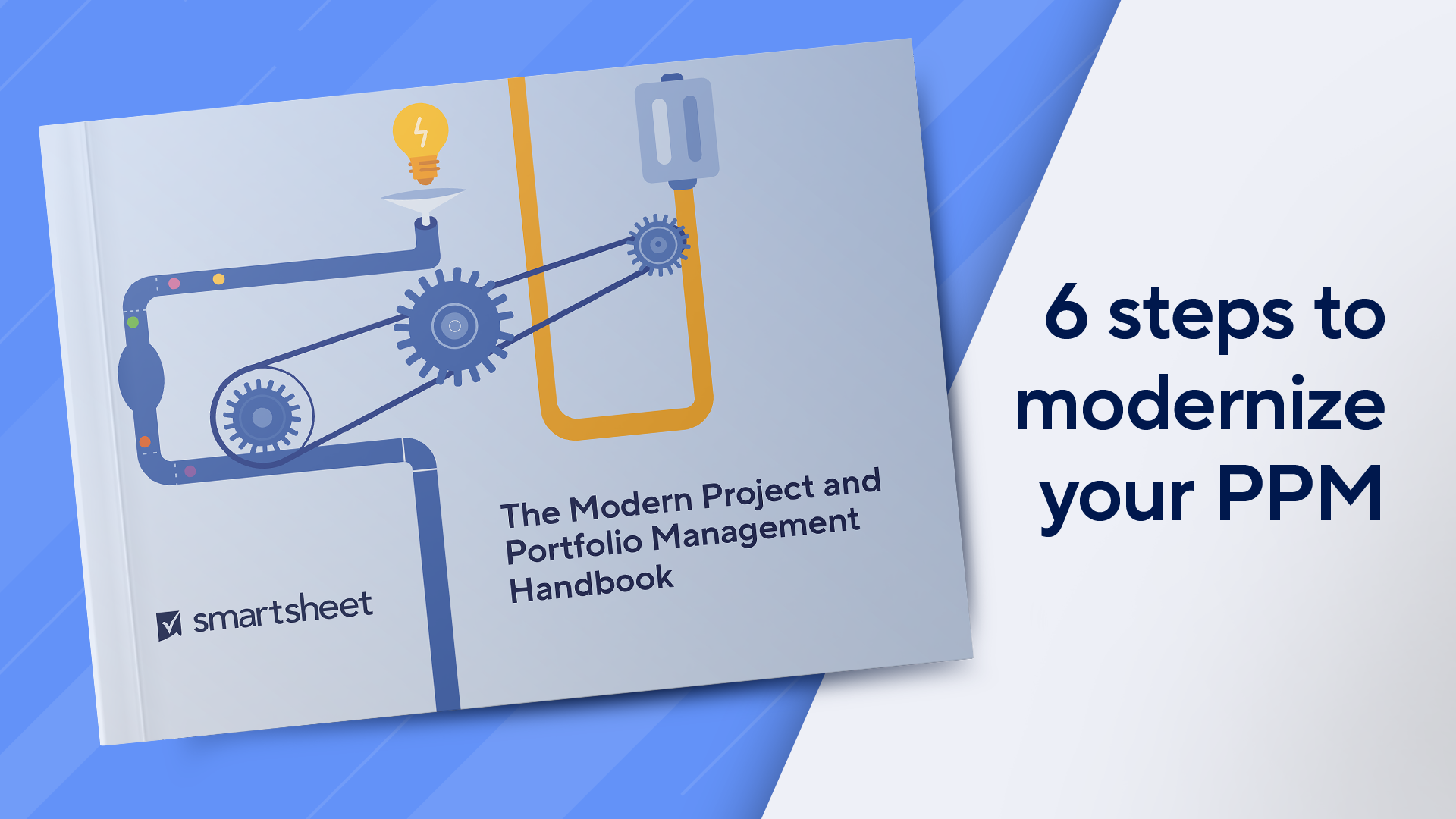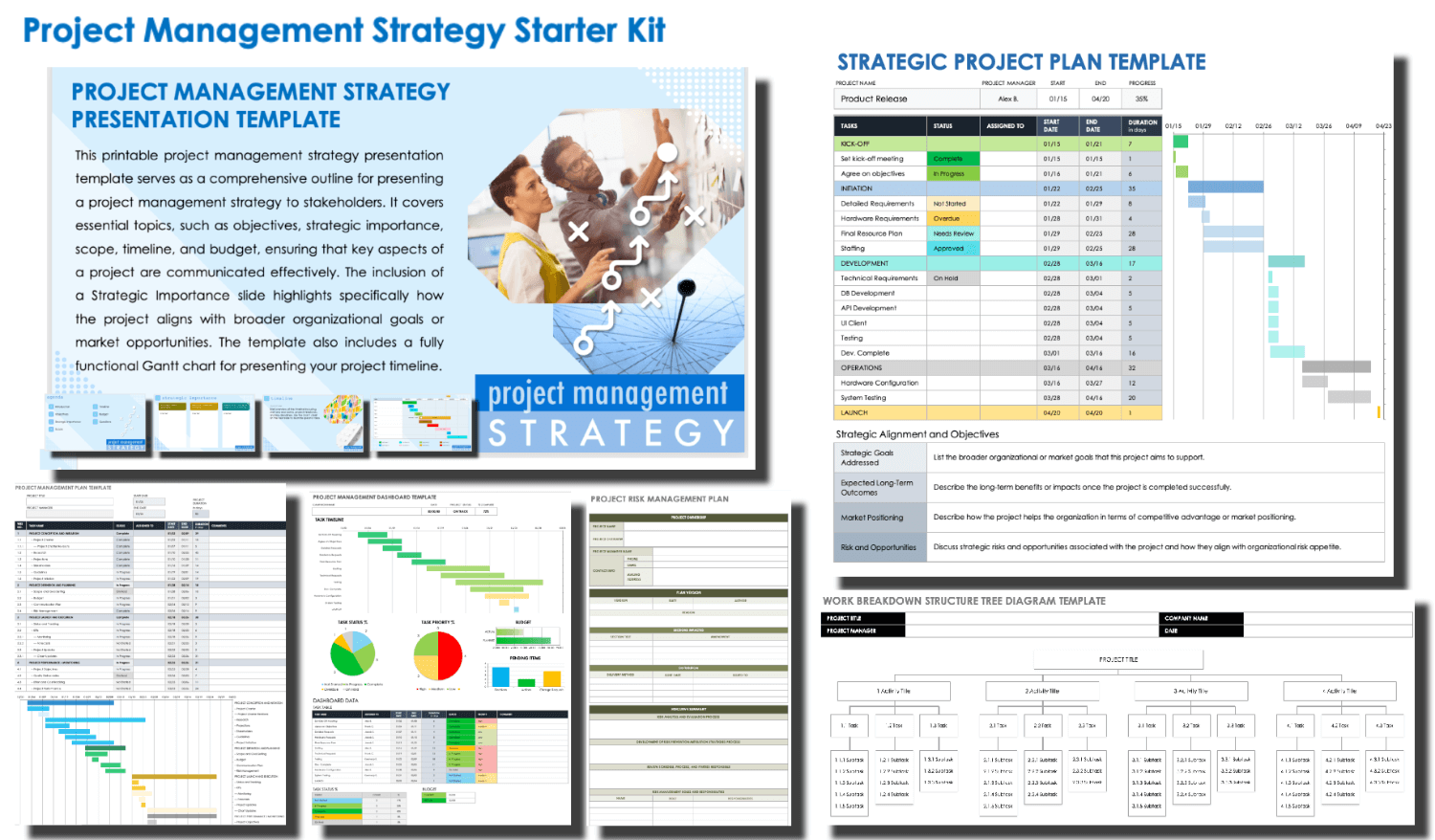What Is Strategy in Project Management?
In project management, strategy refers to the high-level plan or approach designed to achieve specific goals or objectives within the constraints of time, resources, and budget. It provides the overarching framework that guides project planning, execution, monitoring, and completion.
“Strategy involves identifying goals, prioritizing tasks, allocating resources, and mitigating risks to ensure successful project completion,” says Kiran Mehra, Co-Founder and President of Goldspot Pens.
Project management strategies help project managers adapt in order to meet challenges throughout a project, thus saving organizations time and money by increasing efficiency during the planning phase. These strategies also serve to align each team member with a common goal, encouraging collaboration and increasing the likelihood of project success.
What Is Strategic Project Management?
Strategic project management extends beyond the traditional scope of project management to align projects, programs, and portfolios with an organization's larger business strategy. This process contextualizes projects in regard to a company's business objectives, competitive landscape, and market trends.
“Strategic project management is used when projects are complex, have long-term implications, or require alignment with organizational goals,” says Mehra.
This approach involves prioritizing projects that align with long-term goals, managing resources across multiple projects for optimal impact, and creating project plans that explain how projects fit within the larger organizational strategy.
The Modern Project and Portfolio Management Handbook
A modern approach to project and portfolio management can help equip you and your teams to tackle projects and programs at scale.

This handbook will help you:
Identify pain points in your current processes
Learn from examples of businesses using modern PPM strategies
Implement your own updated PPM strategy
What Are Project Management Strategies?
Project management strategies are high-level plans or approaches that guide the planning, execution, and completion of a project. Examples include the Waterfall model, Agile methodology, Lean project management, Six Sigma, the critical path method (CPM), and adaptive project framework (APF).
Executing a project management strategy often begins by defining clear goals early in a project, a process that serves to align your team members regarding a desired outcome. This is a critical first step in strategies such as Waterfall and Agile, where having a common focus provides direction for all subsequent activities.
Monitoring and communication are also key elements in many project management strategies, such as Scrum and PRINCE2. Keeping an eye out for upcoming changes and preparing for them is essential for risk mitigation. Frequent and transparent communication, both among team members and with clients, ensures that everyone is aware of a project's status and any potential obstacles on the horizon. Taking such precautions are integral to Lean and Six Sigma strategies, which focus on optimizing resources and processes. To accurately assess budget and resource needs, your team must have a clear understanding of project scope.
“Identifying the right project management strategy requires considering factors such as project scope, objectives, stakeholders, and available resources,” says Mehra. “It involves analyzing a project's characteristics and selecting an approach that best suits them.”
18 Project Management Strategies to Boost Efficiency
Project managers can choose from countless strategies to enhance team performance and boost efficiency. Some common examples include Waterfall, Agile, Scrum, the critical path method (CPM), Kanban, PERT, PRINCE2, and Six Sigma.
Here are 18 of the most effective project management strategies, including guidance on when and when not to use them:
| Strategy | Description | When to Use | When Not to Use |
|---|---|---|---|
| Adaptive Project Framework (APF) | Adapts to changes and enables continuous improvement | For projects with high levels of uncertainty and changing requirements | When scope and deliverables are well-defined |
| Agile Methodology | Emphasizes iterative collaboration and flexibility | For rapidly changing or highly uncertain requirements | When detailed planning and risk assessment are required |
| Critical Chain Project Management (CCPM) | Focuses on resource leveling and constraints | For projects in which resources are limited and optimization is essential | When resources are abundant or speed is more critical |
| Critical Path Method (CPM) | Identifies the longest path of planned activities | For complex projects with multiple dependencies | When projects are simple or highly uncertain |
| Earned Value Management (EVM) | Measures performance and progress | For projects in which rigorous tracking of cost and performance is necessary | When projects have less strict cost and performance requirements |
| Extreme Programming (XP) | Prioritizes technical excellence and customer satisfaction | For software projects requiring high-quality output and frequent changes | When projects have fixed requirements and don’t involve software |
| Integrated Project Management (IPM) | Emphasizes integrated planning and control | For complex projects requiring tight integration | When projects are simple and elements are loosely connected |
| Kanban System | Visualizes workflow and limits work in progress | For projects in which tasks and priorities change frequently | When tasks are highly dependent and sequential |
| Lean Project Management | Maximizes value while minimizing waste | For projects in which efficiency is the primary concern | When complexity and quality outweigh speed |
| PRINCE2 | Provides a structured, governance-based framework | For projects in which governance, roles, and responsibilities are key | When projects are small and simple and don’t require strict governance |
| Process-Based Management | Aligns objectives with a company’s capabilities | For projects in which alignment with organizational processes is critical | When projects are fast-paced and require frequent changes |
| Program Evaluation and Review Technique (PERT) | Utilizes event-oriented network analysis | For projects with uncertainty in the duration of activities | When activities and durations are well-defined |
| Scrum Framework | Operates as an Agile framework with specific roles and ceremonies | For projects in which quick iterations and frequent reassessments are necessary | When a team is untrained in Scrum or stakeholder involvement is low |
| Six Sigma | Uses a data-driven approach to eliminate defects | For projects in which quality control and zero defects are priorities | When projects are fast-paced and iterative |
| Spiral Model | Combines iterative development with Waterfall control | For risk-heavy or large-scale complex projects | When projects have limited risk or complexity |
| Timeboxing | Allocates fixed time periods for activities | For projects in which deadlines are tight and prioritization is essential | When activities require flexible time allocation |
| Waterfall Model | Follows a linear and sequential approach | For well-defined projects with clear requirements | When requirements are rapidly changing or uncertain |
| Work Breakdown Structure (WBS)-Based Management | Divides a project into smaller, manageable pieces | For detailed planning and task management | When projects are small |
“My top three favorite project management strategies are Agile, Lean, and Waterfall,” says Mehra. “I like Agile because it promotes collaboration, flexibility, and continuous improvement. Lean focuses on eliminating waste and optimizing processes, both of which help improve efficiency. Waterfall is useful when the project requirements are well-defined and sequential execution is necessary.”
Types of Project Management Strategies
There are various types of project management strategies, each designed to address specific challenges, objectives, and work environments. Examples include sequential and linear, Lean and efficiency focused, governance oriented and standardized, visual and board based, and Agile and iterative.
Here are some categories of project management strategies, with examples of each:
Joseph Braithwaite, author and Technology Transformational Program Executive at EvolveThinking, recommends that you keep your strategy comprehensive, no matter what type of strategy you choose.
“A sound strategy will include the following: a communication strategy (which outlines whom to share information with, when to share it, and how to share it); a work strategy (which concerns the pillars of work that are necessary to complete a project, the people who need to complete them, and the deadline for completion); a release strategy (which addresses release timing, the potential impact of releases, the details of any backout plans, etc.); a change management strategy (which delineates the nature of staff, process, and technology changes, the plan for getting buy-in from different stakeholders, the impact assessment of any changes, etc.); a risk strategy; and an issues mitigation strategy,” he says.
“Each of these [project management strategies] on their own requires extensive insight, planning, and knowledge of the following: the defined objectives of a project, its stakeholders, other activities going on within an organization, the economic climate of an industry, and a clear understanding of the potential impacts (positive and negative) for an organization’s customer base,” says Braithwaite.
Why Use Project Management Strategies?
Using project management strategies helps teams stay organized, finish tasks more quickly, and improve the quality of their work. These strategies make it easier to handle problems, communicate clearly, and keep everyone accountable, leading to more overall project successes.
Here are some benefits you can expect from implementing an appropriate project management strategy for your next project:
- Enhanced Organization: Having a strategy in place helps keep everyone on the same page.
- Accelerated Timelines: Effective planning and organization enable the project to be completed more quickly, freeing up time for other activities.
- Better Resource Allocation: Planning ahead allows for the more efficient allocation of resources, which reduces the overall cost of the project.
- Improved Quality: Many strategies incorporate quality checks, which help to ensure that the final product meets or exceeds expectations.
- Clearer Team Communication: Using a cohesive strategy gives all team members a common framework and vocabulary for discussing various aspects of the project.
- Increased Stakeholder Satisfaction: Effective project management often results in meeting or exceeding the expectations of stakeholders.
- Greater Flexibility: Certain strategies are designed to allow for easy adaptation to changes or unexpected problems.
Using a project management strategy can mean the difference between success or failure, so it's a critical part of any project.
Project Management Strategy Documents
Project management involves an array of tasks and responsibilities, and documentation plays a crucial role in organizing and tracking information. Risk registers, resource allocation charts, and roadmaps are all common types of documentation that are used in project management strategy.
“When practicing strategic project management, I use various types of documentation, such as project charters, scope statements, work breakdown structures, project plans, risk assessments, and progress reports,” says Mehra. “These documents help communicate project goals, define tasks, allocate resources, track progress, and address potential issues throughout the project lifecycle.”
Here are some examples of project management strategy documents:
- Project Charter: The project charter defines a project’s purpose, scope, and key stakeholders. It is typically created at the beginning of a project to formally initiate the project. See examples of project charters.
- Project Management Plan: The project management plan outlines the complete framework for managing all aspects of a project. This document serves as a guiding roadmap throughout the project lifecycle. Review different types of project management plan templates.
- Scope Statement: The scope statement provides a detailed description of a project’s objectives, deliverables, constraints, assumptions, and acceptance criteria. It sets clear boundaries and expectations for the project. Check out a wide range of project scope statement templates.
- Resource Calendars: Resource planning calendars indicate when project resources, such as team members or equipment, are available. These are often used in the planning and execution phases. Find more resource planning templates for your needs.
- Risk Management Plan: The risk management plan identifies potential project risks and outlines strategies for managing them. Learn more about risk management plan templates.
- Progress Reports: Progress reports update stakeholders on the status of a project, including metrics on the performance, schedule, and costs. Take stock of your day-to-day work with daily progress report templates.
- Meeting Minutes: Meeting minutes reports record the key decisions, action items, and discussions that occur during project meetings. They are generated after each meeting to ensure that team members have a shared understanding and record of what was decided. Stay on top of your sessions with meeting minutes templates.
- Issue Logs: Issue logs are used to track and manage problems or issues that arise during a project. Record and monitor your project concerns with issue tracking templates.
- Project Closure Report: Project closure reports summarize the performance of a project and highlights lessons learned. Bring your project to an end with these project closeout templates.
These documents cover the essential aspects of project management, from initiation and planning to execution and closure.
Project Management Strategy Templates
Project management strategy templates provide a framework that helps ensure all key elements of a project are accounted for. Templates also promote consistency across projects, making it easier to monitor performance, meet stakeholder expectations, and streamline management processes.
Project Management Strategy Presentation Template
Download a Project Management Strategy Presentation Template for
PowerPoint
| Google Slides
This printable project management strategy presentation template serves as a comprehensive outline for presenting a project management strategy to stakeholders. It covers essential topics, such as objectives, strategic importance, scope, timeline, and budget, ensuring that key aspects of a project are communicated effectively. The inclusion of a Strategic Importance slide highlights specifically how the project aligns with broader organizational goals or market opportunities. The template also includes a fully functional Gantt chart for presenting your project timeline.
For additional support with strategic project management, try these free, downloadable project execution plan templates.
Strategic Project Plan Template
Download a Strategic Plan Template for
Excel
| Google Sheets
This enhanced strategic project plan template combines a Gantt chart — for tactical project planning — with a strategic alignment and objectives section in order to contextualize a project within broader organizational or market goals. The Gantt chart lays out the timeline for tasks, responsible parties, and the status of each activity, providing a visual representation of the project's progress and deadlines. The strategic section outlines how the project aligns with larger organizational objectives, expected long-term outcomes, and market positioning.
For more spreadsheet templates to help you plan your project, check out these fully editable project plan templates for Excel.
Project Management Strategy Starter Kit
Get everything you need to manage your projects strategically with this free, downloadable project management strategy starter kit. The kit includes a work breakdown structure tree diagram template, a project risk management plan template, and more, all in one easily accessible file.
Download the Project Management Strategy Starter Kit
In this kit, you’ll find the following:
- A project management strategy presentation template for PowerPoint and Google Slides to help you outline the most important strategic elements of your project.
- A project management plan template for Excel to help you chart tasks along a timeline.
- A work breakdown structure (WBS) tree diagram template for Excel to help you identify tasks, allocate resources, and set up a realistic timeline.
- A project risk management plan template for Excel to document potential risks and plan mitigation responses.
- A project management dashboard template for Excel to track and share project progress over time.
Why Use a Project Management Strategy Template?
Project management strategy templates offer a pre-defined structure that you can easily adapt to your specific needs. With a template, you don't have to start from scratch, thereby saving time and reducing the chances of missing crucial elements.
These templates often include sections for defining objectives, identifying stakeholders, allocating resources, and setting timelines, which means that you can focus on content rather than format.
In an article for the Project Management Journal, “A Complexity Framework for Project Management Strategies,” James Taylor explains that the high rate of schedule and budget overruns in technology projects can be attributed to organizational issues and other factors that can be readily addressed. Field-proven tools such as project management strategy templates can help eliminate these issues.
By using a standardized template, you create a consistent approach to project management within your organization. This method can be particularly beneficial for teams that work on multiple projects simultaneously or that have high turnover rates, as everyone can refer to the same guiding document.
How to Identify the Right Project Management Strategy
To find the right strategy for your project, look at details, such as the project’s objectives, complexity, and required resources. Then use a simple guide or decision tree to find a method that works for your project.
For example, you can try this decision tree to help you choose among some common project management strategies:
“In order to achieve the desired outcome, that is, to have the biggest positive impact on an organization, each project requires a different approach,” says Braithwaite. “Approaches such as Waterfall work for straightforward, repeatable projects, such as regular software updates and regular office moves.”
“A software development project requires a different level of testing than a construction build; a new car build requires a similar but different project approach than an aircraft project,” he says. “It all depends on what you are trying to achieve and how comfortable an organization is at running a project.”
When to Choose Project Management Strategy Software
Choose project management strategy software when your project has multiple tasks, deadlines, and team members that need to be coordinated efficiently. Software can help teams that require advanced features, such as real-time collaboration, progress tracking, and data analytics.
General project management software offers a broad range of functionalities that cover everything from task assignment to tracking deadlines. Agile and Scrum software is tailored to projects that require flexibility and quick iterations, allowing teams to adapt to changes efficiently.
Deciding to use software can be a big investment, so it’s important to understand when to use software and when not to use it. Here’s a chart that helps compare and contrast the differences between using software and maintaining a manual approach to project management.
| Criteria | Software | Manual |
|---|---|---|
| Setup Costs |
|
|
| Ongoing Costs |
|
|
| Time Savings |
|
|
| Productivity Gains |
|
|
| Error Rates |
|
|
| Scalability |
|
|
| Compliance and Reporting |
|
|
| Customization |
|
|
| Collaboration |
|
|
| Data Security |
|
|
| Accessibility |
|
|
To better understand all your software options, see this comprehensive guide to project management software. For an overview of what project management strategy software can do for your team, see this article on project management software.
Turbo-Charge Your Project Management Strategies with Smartsheet
From simple task management and project planning to complex resource and portfolio management, Smartsheet helps you improve collaboration and increase work velocity -- empowering you to get more done. The Smartsheet platform makes it easy to plan, capture, manage, and report on work from anywhere, helping your team be more effective and get more done. Report on key metrics and get real-time visibility into work as it happens with roll-up reports, dashboards, and automated workflows built to keep your team connected and informed. When teams have clarity into the work getting done, there’s no telling how much more they can accomplish in the same amount of time. Try Smartsheet for free, today.




